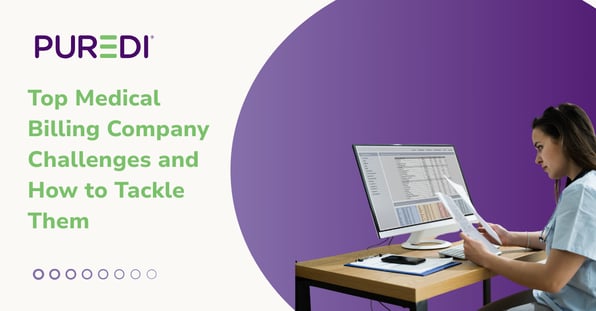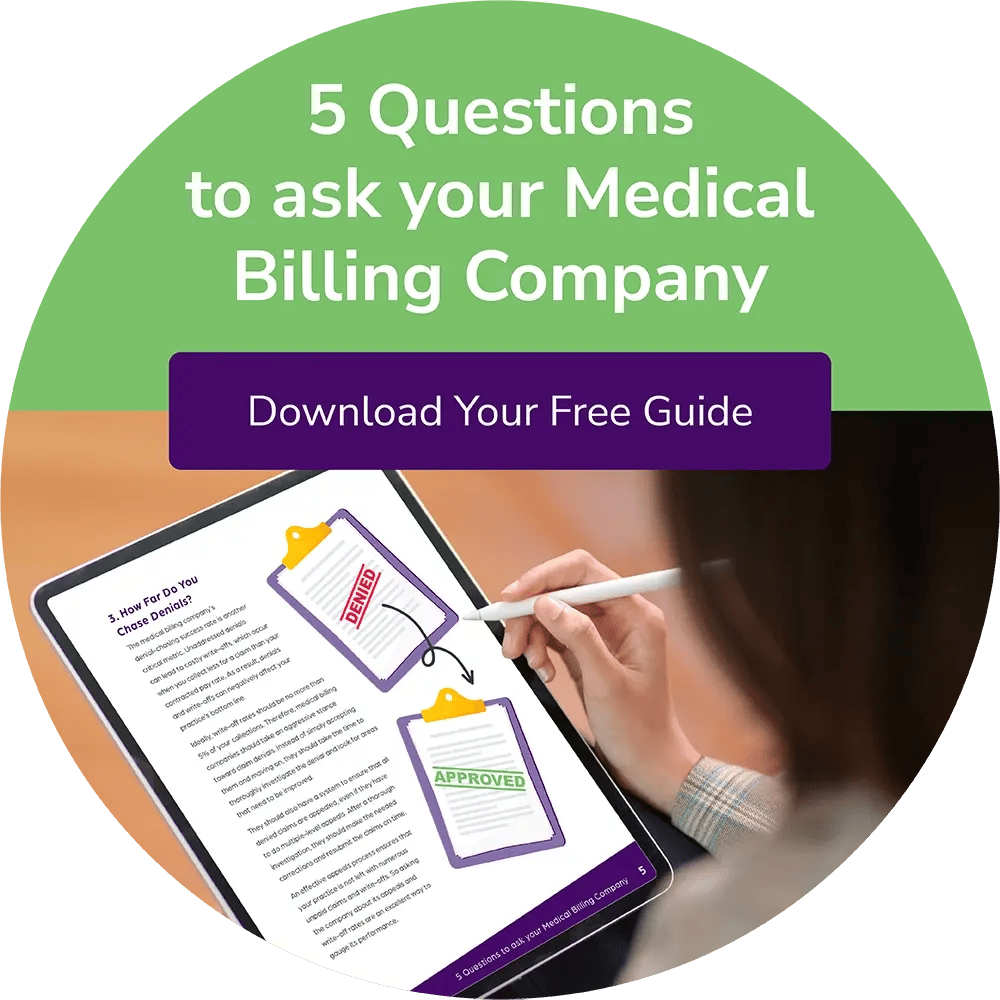Top Medical Billing Company Challenges and How to Tackle Them

Medical billing companies encounter various challenges that impact their efficiency and profitability. This article discusses the primary medical billing company challenges, including administrative burdens, coding errors, regulatory compliance, and insurance denials, along with practical solutions to address them.
Key Takeaways
-
Healthcare providers face significant administrative burdens in medical billing due to complex regulations and coding requirements, necessitating the implementation of technology and streamlined workflows to enhance operational efficiency.
-
Coding errors and claim denials pose major challenges to timely payments, making consistent staff training and quality control measures essential for reducing inaccuracies and improving revenue cycle management.
-
Maintaining compliance with ever-changing regulatory requirements is crucial; healthcare organizations should utilize compliance software and stay informed to mitigate legal risks and ensure adherence to billing standards.
Administrative Burdens in Medical Billing
The administrative burdens in medical billing are like an ever-growing mountain that healthcare providers must continuously climb. A significant percentage of physicians report feeling overwhelmed by these tasks at least once per week, highlighting the staffing challenges that many practices face. The increasing complexity in payer regulations and coding intricacies contributes to costly delays and errors in medical billing workflows, making it difficult to maintain financial health.
Adding to the chaos are the frequent changes in regulatory requirements, updates to coding guidelines, and data security laws, which further complicate the billing process.
However, technology and services designed to improve administrative processes are providing some much-needed relief. Accurate medical billing practices are crucial for enhancing revenue cycle management, ensuring timely payments, and maintaining financial stability.
Streamlining Workflows
Optimizing operational efficiency and reducing administrative burdens can be achieved by streamlining workflows. Technological innovations such as electronic health records (EHR), artificial intelligence (AI), and billing software can automate tasks and minimize errors, significantly enhancing operational efficiency. Implementing efficient processes such as patient registration, insurance verification, and co-pay collection can mitigate workflow challenges and minimize administrative burdens.
Departmental collaboration also plays a significant role in this process. Effective denial management and appeals processes can be streamlined through continuous monitoring and adaptation of workflows to align with evolving industry standards. This approach not only enhances efficiency but also ensures sustained operational success.
Leveraging Automation Tools
Automation tools revolutionize medical billing. Robotic Process Automation (RPA) can handle repetitive tasks such as data entry, document processing, and claim status monitoring, reducing errors and enhancing workflow efficiency.
Artificial intelligence (AI) can further streamline coding processes and provide predictive insights to optimize revenue cycles. Robust billing software automates various tasks, ensuring a smooth and efficient workflow.
Managing Coding Errors
Coding errors in medical billing can be a significant roadblock to timely payments. Common errors include inaccurate coding, issues with patient information, and insufficient documentation. These mistakes often lead to claim denials and payment delays, creating a domino effect that impacts the entire revenue cycle. Typos and inaccuracies in patient information are among the primary reasons for insurance claim denials, along with incorrect billing.
Advanced billing solutions with features like claim scrubbing can help reduce medical coding errors. Moreover, accurate and complete medical billing requires proper clinical documentation and up-to-date patient information. By addressing these issues, healthcare providers can significantly reduce the risk of claim denials and ensure a smoother billing process.
Training and Education
Consistent training and education keep billing staff updated on the latest coding guidelines and regulatory changes. Workshops and resources help ensure that billing staff comply with current healthcare regulations.
Proper training boosts staff productivity and minimizes coding errors and claim denials.
Implementing Quality Control Measures
Quality control measures are vital for identifying and correcting coding errors before claim submission. Natural language processing (NLP) technologies can significantly enhance accuracy and efficiency in code assignment. Swift error resolution protocols ensure accurate claim submissions, minimizing denials and improving revenue cycle management.
Compliance with Regulatory Requirements
Healthcare organizations find it challenging to maintain compliance with regulatory requirements. The complexity and frequent changes in billing regulations pose significant challenges. Healthcare providers must manage fluctuating payer policies and regulatory changes, which require considerable time and effort. The high legal risks and need to maintain patient safety standards add to the burden of compliance.
Healthcare organizations must be vigilant and proactive to navigate this complex landscape. Adhering to medical billing practices and confidentiality laws prevents compliance failures and penalties.
Staying Updated with Regulations
Staying informed about regulatory changes helps medical billing professionals avoid compliance failures. Maintaining compliance requires keeping up with laws like HIPAA and staying updated with insurance coverage policies.
Attention to detail regarding confidentiality laws is also vital in medical billing.
Utilizing Compliance Software
Compliance software plays a critical role in tracking regulatory changes and ensuring adherence to billing standards. Utilizing coding validation tools can help flag potential errors before claims are filed, thus reducing the risk of non-compliance.
Insurance Claim Denials and Rejections
Common challenges in medical billing include:
-
Insurance claim denials and rejections.
-
One primary reason for claim denials is the treatment being deemed not medically necessary.
-
Claims can also be denied if the treatment is considered experimental without sufficient documentation.
-
Frequent coding mistakes lead to increased claim denials, requiring additional resources to appeal.
-
Physicians reportedly spend twice as long on administrative tasks compared to direct patient interactions, which further complicates the medical billing process. These key medical billing challenges can significantly impact the efficiency of healthcare providers and contribute to rising medical bills.
Addressing fraudulent claims, which cost the industry over $100 billion annually, is a must for healthcare organizations. Proper medical billing practices reduce claim denials and ensure timely reimbursements for healthcare providers.
Accurate Insurance Verification
Preventing claim denials and ensuring timely reimbursements hinges on accurate insurance verification. Challenges in insurance verification include complex insurance policies, varying coverage plans, and frequent changes in insurance information.
Accurate verification processes prevent claim denials and improve financial outcomes for healthcare providers.
Effective Denial Management
A structured denial management strategy helps reduce claim denials. Implementing a systematic approach to tracking and addressing denied claims can significantly improve the overall revenue cycle.
An efficient appeals process is crucial for managing denied claims effectively.
Data Management Challenges
Medical billing faces significant challenges in data management. Managing patient information from multiple sources can lead to difficulties in maintaining data accuracy. Inconsistencies in patient data can result in payment delays if not accurately verified. Timely payments depend on prompt claim submission and accurate patient information.
The integration of Electronic Health Records (EHR) and Practice Management Systems (PMS) can automate and centralize patient data, reducing manual efforts and minimizing errors. This integration is essential for streamlining medical billing processes and enhancing operational efficiency.
Integration with Electronic Health Records (EHR)
Medical billing integration with EHR systems boosts efficiency, accuracy, and quality control through medical billing software.
This integration ensures smoother data exchange, enhancing operational efficiency and improving patient care.
Ensuring Data Security
Safeguarding sensitive patient information requires adherence to confidentiality laws. Confidentiality law violations lead to legal consequences and damage the reputation of medical billing practices.
Protecting patient data is vital to maintain trust in healthcare services and uphold privacy.
Technology Adoption and Training
Advanced billing technologies significantly enhance revenue cycle efficiency. Healthcare organizations must stay current with technological innovations. This is crucial for maintaining a competitive edge in the industry. Strategic planning and stakeholder engagement are vital for smooth transitions to new technologies in healthcare.
Effective communication is vital during this process. A structured plan keeps stakeholders informed and engaged, minimizing resistance to change.
Embracing New Technologies
New medical billing technologies significantly enhance billing efficiency and accuracy. Technologies such as robotic process automation (RPA) can automate high-volume tasks, reducing manual labor and errors.
However, staff must invest significant time in training to adapt to these new technological updates effectively.
Continuous Staff Training
Ongoing training keeps billing staff updated on new technologies and coding practices. Ongoing training and support help staff adapt to new systems, reducing resistance and enhancing proficiency.
Financial Performance and Cash Flow Management
Billing complications delay revenue generation and significantly affect a healthcare facility’s cash flow. Inaccurate coding delays payments from insurance companies, impacting cash flow and reducing revenue generation. Administrative expenses in healthcare can account for as much as 30% of total costs, highlighting the need for streamlined billing processes.
Continuous monitoring identifies areas for improvement and ensures sustained efficiency in billing processes. Regularly assessing performance metrics helps refine and enhance billing practices.
Timely Reimbursement
Automation and AI reduce manual efforts, minimize errors, and provide insights for efficiency improvement. Automated claim submission facilitates faster reimbursement cycles, allowing providers to receive payments more quickly. Timely reimbursement maintains healthy cash flow and ensures financial stability in healthcare practices.
Managing Accounts Receivable
Regular accounts receivable audits identify inefficiencies and improve collection rates. The accounts receivable process in healthcare is complicated by the presence of various insurance payers, each with distinct reimbursement policies.
Regular audits help healthcare providers streamline accounts receivable processes and ensure timely payments.
Enhancing Patient Satisfaction
Effective billing communication directly influences patient satisfaction and their overall healthcare experience. Upfront transparent communication about payment expectations improves patient understanding and compliance. Effective billing processes can significantly reduce patient stress, thereby fostering trust and enhancing overall satisfaction.
Clear billing practice communication fosters patient satisfaction in healthcare. Direct communication lines clarify patient financial responsibilities and reduce misunderstandings.
Clear Communication Channels
Direct communication lines help clarify patient financial responsibilities and reduce misunderstandings. Proactive communication about billing procedures can alleviate confusion and minimize frustrations for patients.
Accurate payment estimations enhance patient engagement and satisfaction by facilitating better financial planning.
Transparent Billing Practices
Open and clear billing practices build patient trust and minimize unexpected costs. Integrating transparent billing methods fosters trust between healthcare providers and patients, contributing to higher satisfaction rates.
Simplified billing statements and clear cost information build trust between patients and healthcare providers.
Overcoming Resistance to Change
Staff resistance to new processes is a common challenge in medical billing. Fostering a culture of continuous learning and innovation helps healthcare providers navigate changes successfully. Understanding staff emotional responses and providing ongoing support helps address resistance to change. Staying updated with industry trends is crucial to overcoming medical billing challenges. Staying abreast of regulatory changes and technological advancements is also crucial.
Engaging staff through clear communication about the benefits and impact of new processes is crucial. Transparency and soliciting feedback build trust among staff. Phased changes let organizations test and refine new processes before full implementation, minimizing disruption.
Engaging Staff in Change Management
Successful engagement of staff during changes requires clear communication about the benefits and impact of the new processes. Building trust among staff is essential and can be achieved through transparency and soliciting feedback.
Phased changes let organizations test and refine new processes before full implementation, minimizing disruption.
Monitoring and Refining Processes
Continuous monitoring and refining of billing processes ensure prompt identification and addressing of inefficiencies. Efficient workflows significantly reduce administrative burdens and improve operational efficiency. Quality control measures identify and correct coding errors before claim submission, refining processes.
New technologies streamline billing processes and enhance accuracy, leading to fewer errors and faster claim processing.
Summary
Navigating the complex world of medical billing requires a multifaceted approach. By addressing administrative burdens, managing coding errors, maintaining regulatory compliance, ensuring accurate insurance verification, and adopting new technologies, healthcare providers can overcome the myriad challenges they face. Continuous training and effective change management are essential for fostering a culture of continuous improvement. Ultimately, these strategies not only enhance financial performance and cash flow management but also significantly improve patient satisfaction. By implementing these solutions, medical billing companies can transform challenges into opportunities for growth and success.
Frequently Asked Questions
What are the main administrative burdens in medical billing?
The main administrative burdens in medical billing consist of complex payer regulations, coding intricacies, and frequent changes in regulatory requirements, all of which lead to costly delays and errors in billing workflows. Addressing these challenges is essential for streamlining the process and improving efficiency.
How can coding errors be minimized in medical billing?
To minimize coding errors in medical billing, it is essential to provide ongoing training for billing staff, implement robust quality control measures, and utilize advanced billing solutions that include claim scrubbing features. This approach ensures accuracy and efficiency in the billing process.
Why is compliance with regulatory requirements challenging for healthcare providers?
Compliance with regulatory requirements is challenging for healthcare providers due to the complexity and frequent changes in billing regulations, coupled with high legal risks and the imperative to uphold patient safety standards.
What strategies can help reduce insurance claim denials?
To reduce insurance claim denials, it is essential to implement accurate insurance verification, establish a structured denial management strategy, and streamline the appeals process. These measures ensure thoroughness and efficiency in handling claims.
How can patient satisfaction be enhanced in the billing process?
Enhancing patient satisfaction in the billing process necessitates clear communication regarding billing procedures, transparent practices, and proactive notifications about payment expectations. These measures create a more positive experience for patients.
Blog Post Tags
Medical Billing SoftwareGet Awesome Content Delivered Straight to Your Inbox!
Posts by topic
- RCM
- Medical Billing Software
- Outsource Your Medical Billing
- Compliance
- Physician Billing Services
- Denial Management
- AI
- Data Analytics
- EHR
- ERA
- reporting
- Automation
- Business
- Claim Scrubbing
- Coding
- Community
- Events
- LTPAC
- Medical Billing Companies
- Medicare
- Press Release
- Revenue Cycle Management
- business development
- clearinghouse See All See Less





